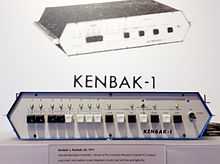Kenbak-1

The Kenbak-1 is considered by the Computer History Museum and the American Computer Museum[1] to be the world's first "personal computer".[2] Only 40 machines were ever built and sold. It was designed and invented by John Blankenbaker of Kenbak Corporation in 1970, and was first sold in early 1971. The system first sold for US$750.[3] Only around 10 machines are now known to exist worldwide, with various collectors. In 1973, production of the Kenbak-1 stopped as Kenbak Corporation folded.[4]
Since the Kenbak-1 was invented before the first microprocessor, the machine didn't have a one-chip CPU but instead was based purely on discrete TTL chips. The 8-bit machine offered 256 bytes of memory (=1/4096 megabyte). The instruction cycle time was 1 microsecond (equivalent to an instruction clock speed of 1 MHz), but actual execution speed averaged below 1000 instructions per second due to architectural constraints such as slow access to serial memory.[5]
To use the machine, one had to program it with a series of buttons and switches, using pure machine code. Output consisted of a series of lights.
See also
- Datapoint 2200, a contemporary machine with alphanumeric screen and keyboard, suitable to run non-trivial application programs.
References
- ↑ http://www.compustory.com/Pioneers.html
- ↑ http://www.computerhistory.org/timeline/?year=1971 Timeline of Computer History, retrieved July 22, 2008
- ↑ http://books.google.com/books?id=wCl2yLDv2bAC&pg=PT42&dq=Kenbak-1&hl=en&sa=X&ei=bEPqTsXUG4GwiQKO1sC-BA&ved=0CDoQ6AEwAQ#v=onepage&q=Kenbak-1&f=false
- ↑ p. 52, "The First Personal Computer", Popular Mechanics, January 2000.
- ↑ http://www.old-computers.com/museum/computer.asp?st=1&c=1259
External links
- KENBAK-1 Computer Article
- KENBAK-1 Computer – Official Kenbak-1 website at www.kenbak-1.net
- KENBAK-1 Series 2 – Official Kenbak-1 reproduction kit at www.kenbakkit.com
- Kenbak-1 Emulator – Online Kenbak-1 Emulator
- Kenbak-1 Emulator – Offline Kenbak-1 Emulator
- The Kenbak 1 - The first Personal Computer – At the Computer Museum of Nova Scotia
- Kenbak 1 – Images and information at www.vintage-computer.com
- Kenbak-1 video – Watch Kenbak-1 replica running a simple program at www.oldcomputermuseum.com
- Kenbak documentation at bitsavers.org
- KENBAK-uino Hardware-based Kenbak-1 Emulator
- Recreating the First PC article about KENBAK-uino at hackaday.com
- KENBAK-1 Emulator/Trainer, RetroWiki.es